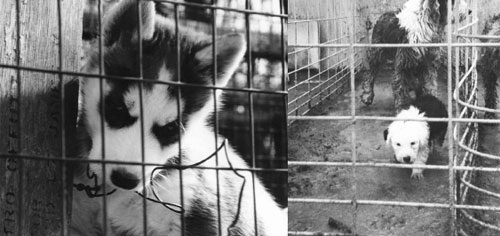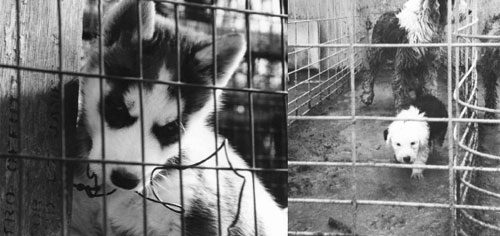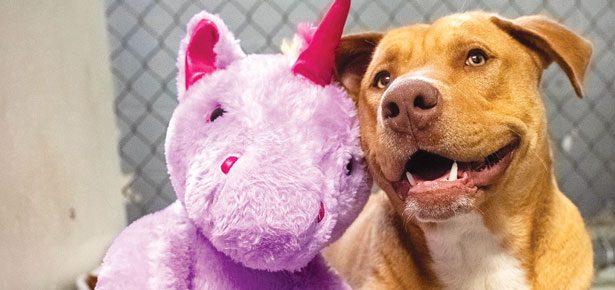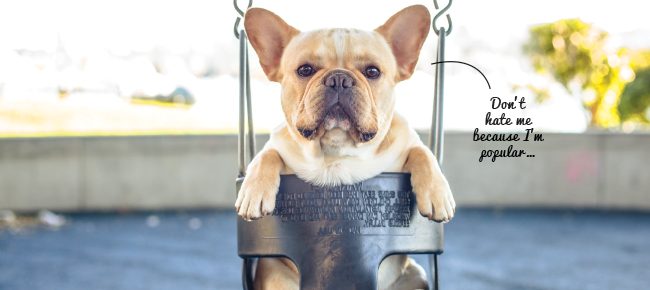

Puppy Hell: The Horrors of Puppy Mills
The term "puppy love" conjures images of teen couples passing notes in the school hallway. All is warm and fuzzy. The term "puppy dog eyes" brings to mind big, droopy, please-love- me peepers reflecting innocence and loyalty. Both of these colloquialisms are made all the more appealing by virtue of one simple word: "puppy." Not only have we come to love the sweet little creatures themselves, but - let's face it - we love the word. Puppy.
The term "puppy love" conjures images of teen couples passing notes in the school hallway. All is warm and fuzzy. The term "puppy dog eyes" brings to mind big, droopy, please-love- me peepers reflecting innocence and loyalty. Both of these colloquialisms are made all the more appealing by virtue of one simple word: "puppy." Not only have we come to love the sweet little creatures themselves, but – let’s face it – we love the word. Puppy.
Perhaps it is this image of gentleness coupled with the jovial cadence of a word we love that has served to mask one of society’s most disgusting realities. For those not in the know, the phrase "puppy mill" might conjure nothing more than an animated, cartoonesque conveyor belt, spewing out tail-wagging baby dogs. From an I Love Lucy bon-bon factory environment right into the arms of loving families. For many, little more thought is given to the idea of "puppy mill" as place of dog origin than is given to the idea of "stork" as baby origin. Perhaps if we replaced "puppy mill" with a more apt phrase-"torture chamber"-we’d finally be able to stand up and say: "Okay, now I get it." Maybe then our cocktail-party chatter would be less about the dog-du-jour and more about the responsible adoption of, and lifetime commitment to, the dog-de-la-vie.
What is a puppy mill?
Let’s start by getting that quaint old tune out of our heads and stop asking, "How much is that doggie in the window?" Instead, we should be asking, "Where did that doggie in the window come from?" And more specifically, "If I purchase that doggie in the window, what is my money supporting?" Because, quite simply, if the window in which that doggie sits is one belonging to a pet store, more than likely, that doggie came from a puppy mill. In a 2004 article in The Province, BC SPCA senior animal-protection officer Eileen Drever explained: "It’s a fact that reputable breeders will not allow their puppies
to be sold through pet stores."
As defined by Canada’s National Companion Animal Coalition, a "puppy mill" is a high-volume, substandard dog breeding operation which sells purebred or mixed-breed dogs. Facilities that mass-produce puppies and put profit above welfare, puppy mills create living conditions for their dogs that are deplorable at best.
Picture, if you will, a warehouse. Imagine, within this warehouse, row after row and shelf after shelf of inventory stuffed into cramped, makeshift cages. The "inventory" in each box is half a dozen or more puppies, frequently hungry, sickly, and covered in the feces of the "inventory" shelved above them. And above them.
But wait. Those conditions are the Club Med of the mill. However neglected these puppies are, their stay will likely be short, given that some mills sell up to 150 puppies a week. The suffering is not so temporary for the lifers. The "breeding stock" animals are imprisoned in overcrowded, filthy cages and repetitively bred-even inbred-until they simply no longer can, often without ever experiencing the luxury of leaving their cages. Minimal vet care, poor-quality food, and small living quarters make up the sub substandard conditions in which countless mothers give birth to hundreds of thousands of puppies yearly.
While a reputable breeder will work with one or two breeds in order to fully understand and care for her puppies, a puppy mill operator may crank out up to seventy different breeds. When the mandate is to produce as many puppies as you can, as fast as you can, and as cheaply as you can, puppy mill dogs are reduced to the status of widgets. According to Stephanie Shain, director of the Stop Puppy Mills Campaign for the Humane Society of the United States (HSUS): "Legally, if an individual treated their pet the way dogs in puppy mills are treated, they could be charged with cruelty or neglect. But these mills are viewed as ‘agriculture’ and too often, the agencies responsible for overseeing them treat them like they are raising corn, not pets."
In 2000, a particularly horrendous case uncovered in Quebec infuriated the nation. The mill was littered with piles of dead, partially eaten dogs, in corners, behind the barn, and even hanging from rafters. Starving adult dogs were found eating their newborn puppies.
So, what is a puppy mill? A puppy mill is the rude, ugly, hateful cousin of the companion-pet world. The cousin who runs the risk of tarnishing the reputation of every member of the family, even the well-meaning ones. The cousin whose branch you wish you could chop from the family tree.
The dogs in our own backyards
Perhaps the biggest barrier that stands between North Americans and puppy mill reality is our distorted perception of self. The Canadian and American public blithely believes that puppy mills couldn’t possibly be as bad as "they" say. Because, we’re civilized, right?
As civilized as the man who stuffed five young Rottweiler puppies into a birdcage and left them there. Naturally, but tragically, these puppies continued to grow and, eventually, too large to be extracted from the cage, had to be euthanized through its bars. This didn’t happen in some far-off Third World country but in our own, tidy North American backyard.
What can be done to punish millers like this one? The first stumbling block in bringing operators to justice is that they actually have to be found, and this is not an industry that works in plain view. In Canada, animal welfare laws differ from province to province. While the law allows for penalties as severe as a $60,000 fine and two years in prison, such sentences are rarely handed down. As Pierre Barnoti, executive director of the SPCA in Quebec explains, in his twelve years with the organization, he has never seen a puppy mill operator serve so much as one day of time.
Barnoti has become an oft-heard and respected voice in the fight for the eradication of puppy mills. He is quick to point out the irony that, at 136 years old, Quebec’s SPCA is the oldest in Canada, yet, up until only months ago, it was the only province with no animal welfare act in place. A mere nine animal welfare inspectors struggle to oversee a geographic area approximately six times the size of France. As such, it is a haven for puppy millers, supplying more dogs to North American pet stores than any other province
or state.
South of the border, Shain estimates that there are easily over 5,000 mills in operation. While some local shelters and governmental agencies do investigate puppy mill conditions and intervene to rescue the animals, in many cases, it’s unclear whether the shelter has the legal authority to step in. Even when they can take action, the magnitude of the situation is often so overwhelming that solving it becomes a monumental task. When a shelter intervenes, they suddenly find themselves with dozens of animals in need of care, housing, and food. A rescue of as few as fifty dogs can cost tens of thousands of dollars.
Unfortunately, puppy mills are more than slipping through cracks. They are plummeting through craters.
The burden is ours
How could something like this not only continue but thrive as a profitable industry?
The answer is simple: Because of us-consumers who walk into pet stores empty handed, and walk out with a new designer dog. Or who see an ad in the paper and hours later pick up a puppy. Who surf the net and-wowed by irresistible photos-order up a dog as if it were a book or bouquet of flowers. In our obsession with having a "purebred" and having it quickly, we feed the industry. Pet stores cater to impulsive buyers seeking convenient transactions.
On the other hand, reputable breeders and shelters care where their puppies go. Alison Brownlie recently became the mom of Taz, a Border Collie-cross rescued from the Vancouver-based That’ll Do Border Collie Rescue. Describing the screening she underwent before adopting Taz, she says: "The application process was incredibly thorough. Once my application was approved, a volunteer came to do a home check. Only after these two filters did I even get to meet him! Then, I had to wait another 24 hours before the adoption would be confirmed. The objective of the shelter is: No snap decisions! This isn’t about a new stuffed toy, this about a possible 15-year friendship."
Breed-specific rescue groups like the one that sheltered Taz exist continent-wide to help match up potential owners with dogs that need homes. In addition, it is a little-known fact that a quarter of all the dogs in shelters are purebreds, so even if you want a purebred, there is no need to buy the dog of your dreams from a pet store when countless are sitting unloved in shelters.
The Pet Industry Joint Advisory Council (PIJAC) estimates that American pet stores alone sell between 300,000 and 400,000 puppies a year. If you estimate something in the range of $500 paid per pet store puppy, that’s an astounding amount of money directly supporting the puppy mill system. No wonder puppy mill operators look at dogs not as "man’s best friend" but as "man’s best cash cow." And the cash is ours. As Shain says: "Puppy mill operators count on people to be so overwhelmed by the cuteness that they just can’t leave the little bundle behind. But people must understand when they take the puppy home, they’ve opened up a space for the next one to fill." Put bluntly: "There is one really easy way to stop puppy mills. And that is not to buy the puppies."
Ignorance is not bliss. We can longer wince at cocktail parties: "Oh no, I can’t hear about it." We must hear about it. We must turn our backs on anyone who cannot tell us where that doggie in the window came from. We must be able to say: "Okay, now I get it."
When it comes to putting the innocence back in the word "puppy," the burden is entirely ours. ■
Mary-Jo Dionne is a Vancouver-based writer. Her six-pound terrier Cowboy is a testament to the fact that you really can find small dogs at a shelter, while her dog Nelly, adopted as a puppy from a Border Collie rescue group via PetFinder.com, is a testament to the fact that you really can find the breed you want at a shelter.
Join the newsletter and never miss out on dog content again!
"*" indicates required fields
By clicking the arrow, you agree to our web Terms of Use and Privacy & Cookie Policy. Easy unsubscribe links are provided in every email.





